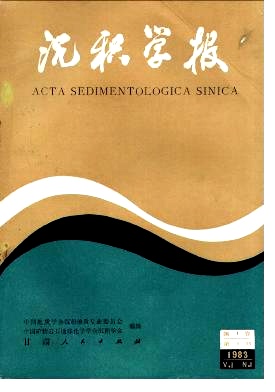TYPES AND ENVIRONMENTAL SIGNIFICANCE OF ONCOIDS FROM YONGXIAN FORMATION OF THE UPPFR DEVONIAN IN SIDING,GUANGXI
- Received Date: 1982-04-13
- Publish Date: 1983-03-10
Abstract: Oncoids occur abundantly in the calcarenite and the pelletal limestone in the lower part of the third limestone member from Yongxian formation of the upper Devonian in Siding, Guangxi. The content of the oncoids is about 15-30%. They are mostly elliptical bodies with diameters ranging from 0.5 to 2 cm, even up to 65 cm in maximum. On the basis of the microscopic study, they are all of algal origin. They are mainly of four species such as algae-Ortonell sp, Mitcheldeania sp, Rothopletzella sp and Lithophyllum sp. Four main types of internal laminae of the oncoids may be recognized: ( 1 ) micritic lamina, ( 2 ) grumose lamina, ( 3 ) organism-bearing lamina and ( 4 ) algal lamina. They were basically formed by micritic and algal lamina surrounding an intraclast or a bioclast, or by the interlayers of micritic, grumose and algal lamina surrounding a bioclast or an intraclast. According to the characteristics of the shapes,they may be divided into the cap-form, petal-form and subellipsoidal-form. The laminae of cap-form grew upward so as to pile up and those of petal-form grew irregularly. They were all formed into inconsecutive laminae.The laminae of subellipsoidal-form grew continuously. The growth of the laminae was controlled by the movement of water body. The algae always grew towards the sunshine. If the water body persisted in agitation and oncoids turned over continuously, the oncoids formed continuous laminae. If the water body agitated weakly and oncoids rested or turned over intermittently, the oncoids formed inconsecutive laminae. Thus the oncoids of cap-form and petal-form were formed in the environment of shallow water with weak agitation and low energy. The oncoids of subellipsoidal-form were formed in the environment of persistent agitation and high energy. Oncoids of cap-form and petal-form mainly occur in pelletal limestone and subellipsoidal-form ones occur in calcarenite.It is suggested that the environment of the formation of the oncoids coincided with that of accumulation.
| Citation: | Zeng Yungfu, Zhang Jinquan, Lin Wengiu, Ye Yaping. TYPES AND ENVIRONMENTAL SIGNIFICANCE OF ONCOIDS FROM YONGXIAN FORMATION OF THE UPPFR DEVONIAN IN SIDING,GUANGXI[J]. Acta Sedimentologica Sinica, 1983, 1(1): 42-49. |






 DownLoad:
DownLoad: